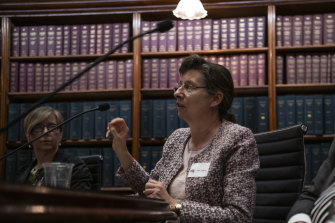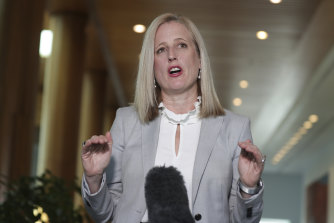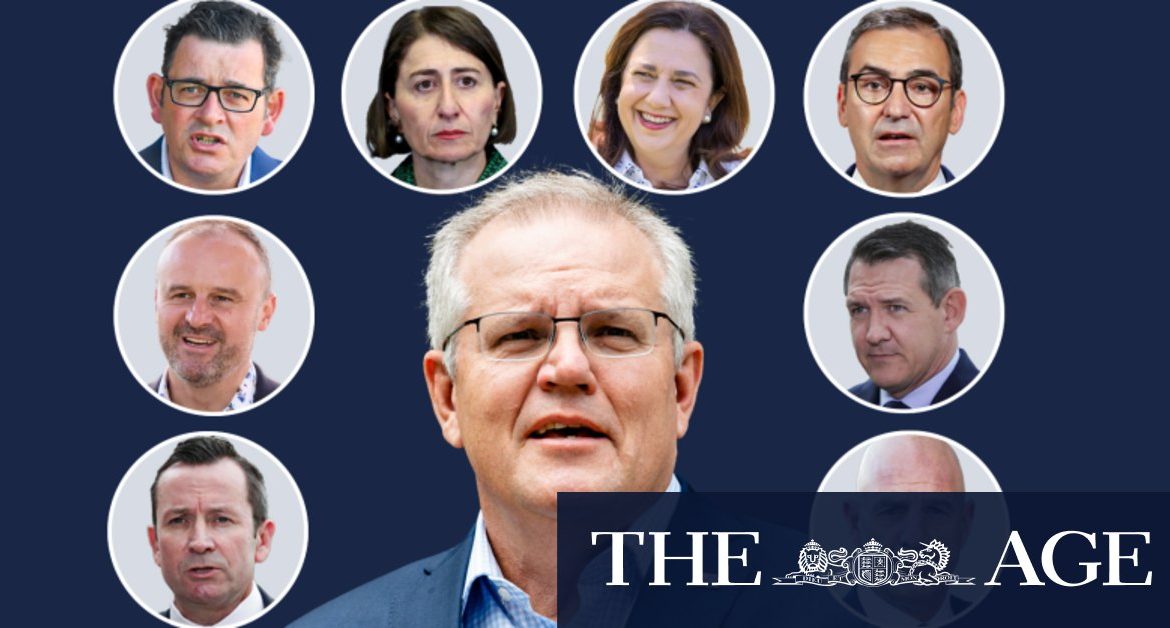Barely a week into its existence, Scott Morrison’s newly formed national cabinet looked like it might fall apart as quickly as it had begun.
It was Sunday, March 22, and the mood going into that evening’s meeting between the Prime Minister, premiers and territory leaders was tense.
Morrison had been blindsided earlier in the day when, 50 minutes into a press conference to announce what was then the biggest spending program ever unveiled by an Australian government, a journalist asked about a tip-off that NSW and Victoria were pushing for a broad lockdown and school closures.
The Commonwealth was about to be handed an object lesson in state muscle, as the greatest public health emergency in a century descended on the nation.
The previous day, local authorities had been forced to close Sydney’s iconic Bondi Beach as thousands flouted new rules banning gatherings of more than 500 people. The number of reported new COVID-19 cases was climbing steeply and the social distancing message wasn’t cutting through. The premiers in the largest states decided they could wait no longer.
In the hours before that Sunday evening meeting, NSW Premier Gladys Berejiklian and Victoria’s Daniel Andrews spoke on the phone. They were worried the other states were not willing to move as fast as their own more populous and exposed jurisdictions.
Looking overseas, they could see intensive care units in Italy and Spain being over-run. In Australia, there were only 2000 ventilators available. If the virus took hold in Sydney and Melbourne it was feared the state health systems would be similarly overwhelmed.
There was suspicion that the Commonwealth was still too focused on viewing the pandemic through an economic lens. The pair decided on a pre-emptive move.
Secretary of the Department of Prime Minister and Cabinet Phil Gaetjens, Prime Minister Scott Morrison and Chief Medical Officer Professor Brendan Murphy speak with NSW Premier Gladys Berejiklian and Secretary of Department of Premier and Cabinet Tim Reardon
(on screen).Credit:Alex Ellinghausen
The Victorian and NSW leaders issued statements flagging their intention to shut down all non-essential services within two days and consider whether schools should stay open. The ACT followed suit. Western Australia’s Mark McGowan and South Australia’s Steven Marshall announced they would close their domestic borders.
That evening, sources in the room say Morrison was annoyed. It was the first big test for the nine-day-old national cabinet. Would the new creation pull together? Or would the federation fracture, as it had threatened to do during the deadly flu pandemic of 1918-1919?
The idea for a national cabinet was born out of a meeting on March 13 of its predecessor body, the Council of Australian Governments, and seems to have been the Prime Minister’s own. A senior federal official says Morrison had in mind the notion of a “war cabinet”, that would cut loose the bureaucratic baggage that made COAG processes so cumbersome.
“He locked it in with Gladys and Dan and they were very strongly supportive, for similar reasons,” the official says. “COAG had become paralysed and too bloated with its subordinate machinery.”
After that first test of relative strength on March 22, the leaders accommodated their differences and came out broadly holding together. Andrews and Berejiklian got the first stage of their proposed shut down but were moderated by other leaders. Stricter rules were adopted two days later on further medical advice.
But the episode threw into sharp relief an enduring truth about this country: while the Commonwealth possesses the deepest pockets, the military, and the power to close external borders, the states have their hands on many of the levers of daily life, and the civilian manpower. Without the armies of state-employed police, nurses, doctors and public health workers, no testing, contact tracing nor quarantine regime was ever going to work.

Bondi Beach being closed in Sydney on
March 21.Credit:Steven Siewert
University of Sydney constitutional law professor Anne Twomey says the pandemic has underscored the fact that the Commonwealth is, at times, “relatively impotent” in what it can do.
She cites a pivotal moment when the states shuttered their schools despite the Commonwealth’s protestations the medical advice didn’t call for it.
Eventually the Prime Minister was forced to concede ground as the leaders agreed to a set of principles to guide each government’s decisions. “If you are going to school in Victoria there is only one person you need to listen to and that is the Premier of Victoria,” Morrison acknowledged. “I want to make this really clear. The Commonwealth does not run public schools, state schools. They are run by state governments. They … set the rules.”
That was a big backdown, Twomey says, “a hard thing for Commonwealth politicians to cope with. They do tend to regard themselves in most cases as all-powerful and the states as irrelevancies that just get in the way”.
The year of the pandemic has been a potent reminder to Australians that “states matter”, she says.
At the same time the Commonwealth’s role has been vital in key areas: marshalling ADF resources to help quarantine operations and logistics, scouring the globe to bolster scarce supplies of personal protective equipment, and underwriting the states’ lockdowns through JobKeeper wage subsidies, increased welfare spending, temporary free childcare and sharing the burden of increased hospital costs. The Department of Home Affairs had a key logistics role through the National Co-ordination Mechanism, activated during national crises.

Professor Anne Twomey says the symbolic leadership of the Commonwealth Government has been important.Credit:Louise Kennerley
Morrison had also absorbed a sharp lesson from the Black Summer fires (when he uttered the immortal throwaway line that “I don’t hold a hose mate”). “Even when the Commonwealth does not have the main role … symbolic leadership is also important,” says Twomey.
National cabinet meetings might have been testy at times but insiders say they generally didn’t descend into shouting matches. Outside the leaders’ meetings, the barbs have flown more freely.
The Ruby Princess debacle in March, when NSW Health allowed more than 2700 passengers to disembark from a COVID-riddled cruise ship without screening for the virus – while the federal government’s Australian Border Force remained all-but invisible – was one flashpoint.
More than half a dozen different agencies were involved in that saga, leaving plenty of ammunition for each side to blame the other.
Treasurer Josh Frydenberg and Home Affairs Minister Peter Dutton have unleashed regular salvos at their home state leaders, Frydenberg hammering Victoria with the charge that its harsh lockdown wouldn’t have been necessary in the first place if the state had better managed its hotel quarantine program.
Queensland leader Annastacia Palaszczuk and WA’s McGowan have come under public and behind-the-scenes pressure over their insistence on keeping their borders closed – even though the Liberal-led states of Tasmania and South Australia had done likewise.

Passengers disembark unchecked from the Ruby Princess cruise ship on March 19 at Sydney’s Circular Quay.Credit:Kate Geraghty
Berejiklian’s verbal jousting with Palaszczuk over Queensland’s long exclusion of NSW residents became increasingly personal. ACT Chief Minister Andrew Barr was frustrated by the long week it took to get Berejiklian on the phone to facilitate travel arrangements for Canberrans stranded at the Victoria-NSW border.
Morrison had high hopes of getting all leaders on board with an agreed definition of a COVID “hotspot” so outbreaks could be ring-fenced without entire states closing to one another again. It didn’t happen.
Despite this the West Australian MP and assistant minister to the prime minister Ben Morton, one of Morrison’s inner circle, insists national cabinet has “not fractured … There’s an ability there for the Commonwealth and for those willing states to get on, to demonstrate the case that’s being made and for those other states to join later”.
Barr says the national cabinet process has highlighted cultural differences between the “Sydney-Melbourne-Canberra” triangle and the other more decentralised jurisdictions. Nevertheless he thinks the range of life experience and political leanings of leaders has created a breadth of perspective that’s served the Prime Minister well.
“It really hasn’t mattered much whether it’s a Labor or Liberal premier, on one level it’s been about the very personal nature of the individuals and their political styles, and the very different interests of jurisdictions within the federation,” Barr says.
Insiders say Berejiklian has got on well with Andrews, but was initially bemused by what she described to others as the “bromance” between him and Morrison.
NSW Chief Health Officer Dr Kerry Chant sits on the peak expert health body advising national cabinet, the Australian Health Protection Principal Committee, which has a core membership of all state, territory and federal chief medical officers. Its members work “really well together” says Chant, “notwithstanding anything else going on in the external environment. Everyone around that table is absolutely committed to doing the best they can”.
Twomey maintains Australia’s decentralised system has been a plus for the country during the pandemic in that states can learn from each other – and each other’s mistakes.
NSW has led the way in demonstrating how to build and run an effective contact tracing system. Victoria’s remodelled and now more stringently policed hotel quarantine system may hold lessons for other states, particularly its new ban on workers in quarantine hotels holding down secondary jobs.
But there are lingering qualms at the federal level about the “test, trace, and contain” capacity of some states. “That’s going to be the test, when we open the borders at scale next year,” says one senior official.
Incumbency has been a plus for those leaders who had to face the electorate this year. Governments were returned in the Northern Territory, the ACT and Queensland. Jacinda Ardern stormed home in the New Zealand election. McGowan in the west is likely to do the same next March on current polling numbers. As federal Labor leader Anthony Albanese reflected ruefully last week, it’s not the easiest time for oppositions: in the middle of a crisis, “people want governments to succeed”.
Trust in government and the public service more generally has soared during the pandemic. Surveys from the ANU’s Centre for Social Research found the proportion of Australians who were confident or very confident in the federal government rose from 27 per cent in January, when the fires were raging, to nearly 57 per cent in April. For state governments, confidence rose from 40.4 per cent to 66.7 per cent.
That level of trust has been one of the keys to the nation’s success in battling COVID-19, says the centre’s Professor Matthew Gray. “When people basically trust the government … they’re much more inclined to do what they are asked to do, even when it’s unpleasant or costly,” he says. “The compliance in Victoria has been extraordinary.”
Western Sydney University assistant vice-chancellor Andy Marks says there was a rising cynicism about politicians before the pandemic hit but now “I think we have seen the return of big government”.
Morrison tapped into this mood addressing Coalition MPs on Tuesday, at their last joint party room meeting for the year. “This year, Australians have probably looked to, and relied upon, the strength and stability and unity of their government more so than they have for many generations,” he said.
Federal Labor’s Katy Gallagher, chair of the Senate committee scrutinising the pandemic response, has been frustrated by the application of cabinet confidentiality to the dealings of national cabinet. She accuses Morrison of using the new body as a “shield … to protect himself from being responsible for anything but at the same time uses it to make it look like he’s in control of everything. It’s pretty clever, really.”
She says it’s ludicrous to label it a “cabinet” when there isn’t any requirement to be bound by collective decision-making, as happens with a cabinet in the conventional sense of the word.
“The federation helped us avoid a bullet in March that was coming our way,” she says. “But, since that time, I just don’t buy this consensus body. When you look at the major issues that have come through there – the social distancing, borders, masks, school attendance – ultimately states have done what they felt they had to do and there hasn’t been a unified position on any of those things.”

Senator Katy Gallagher addresses the media ahead of a Senate select committee hearing on COVID-19, at Parliament House in Canberra.Credit:Alex Ellinghausen
Nevertheless, she’s long thought either COAG or national cabinet works best by having “national lofty goals” and allowing states and territories to tailor their own approaches for local conditions.
Loading
The old COAG process used to be a daunting three or four-day prospect for those in more far-flung parts of the country. Digital technology has changed all that. When events move fast, there’s now a mechanism for leaders to move fast as well. They met no fewer than eight times between national cabinet’s formation on March 13, and when Australians were ordered to stay at home and limit gatherings to two people on March 29.
As the year draws to a close, Berejiklian says national cabinet has been “definitely worth having … I found the process more useful than not, even now. We are a nation and we have got to make it work.”
Says Andrews: “For five years before 2020, COAG for me was a forum where nothing got done. Lots of important discussions, very little action. National cabinet is different. It’s been right for its time and, in my view, it has a bright future.”
You can read more stories in the series here.
Get our Coronavirus Update newsletter
Stay across the news you need to know related to the pandemic. Sent Monday and Thursday. Sign up here.
Katina Curtis is a political reporter for The Sydney Morning Herald and The Age, based at Parliament House in Canberra.
Deborah Snow is a senior writer for The Sydney Morning Herald.
Most Viewed in Politics
Loading







